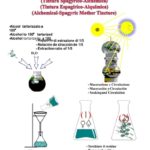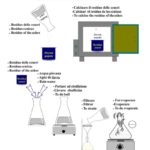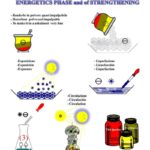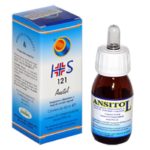TSA (Spagyric-Alchemical Tincture of Solanimus)
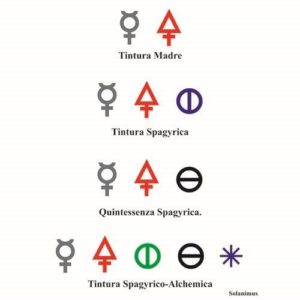 Here we will not discuss operations concerning Alchemy, but purely spagyric operations that will enable us to produce single spagyric products (TSA) or, by mixing the various individual spagyric preparations, then obtain compound spagyric products. We will compare a Spagyric Tincture or Spagyrica, as it is called, and a Spagyric-Alchemical Tincture of Solanimus, we will see that in the beginning the preparation will be the same, but in the continuation there will be important differences.
Here we will not discuss operations concerning Alchemy, but purely spagyric operations that will enable us to produce single spagyric products (TSA) or, by mixing the various individual spagyric preparations, then obtain compound spagyric products. We will compare a Spagyric Tincture or Spagyrica, as it is called, and a Spagyric-Alchemical Tincture of Solanimus, we will see that in the beginning the preparation will be the same, but in the continuation there will be important differences.
Both Spagyric Tincture and Spagyric-Alchemical Tincture are performed starting from a plant that can be fresh or dried; it is always preferable to start from fresh plant, as the active ingredients contained in it will be greater than in the dried plant. Some plants are processed dried as it is almost impossible for us in the West to get them fresh, e.g. Ginseng, Cinnamon, etc.. The plant is harvested, in each case, in its balsamic period, that is, the period when it contains a greater amount of active ingredients; each plant has its own balsamic period, it may be spring, autumn or one of the remaining seasons. Harvest the plant and put it to macerate in a hydroalcoholic solution (water plus alcohol). The alcohol of course will be spagyric alcohol also called “tartaric alcohol,” which in my opinion would be better called “detartaric alcohol” since an attempt is made to remove from it all the tartaric deposits it contains. This alcohol will be at a well-determined degree depending on the plant used (all active ingredients are not extracted with the same alcohol degree, some are more or less water-soluble). Most plants should be macerated in a hydroalcoholic solution that can range from 45 to 55 volumetric alcohol degrees. The plant is macerated in this solution for about 30 days (lunar cycle) and will be at a ratio of 1 in five to the solution (R.E. 1/5), or 4 liters of solution for every kilogram of plant, or rather its dry residue. Dry residue because the ratio should be done with the plant containing no more water (dry residue), this is also to control the alcoholic degree of the solution, to do this just take 100 g of fresh plant and put it in a desiccator oven, dry it, extract it and weigh it (this weight that you will get is precisely called the “dry residue”), if for example now it weighed only 50 g it means that the other 50 g consisted of water, so one kilogram of fresh plant will correspond to 500 g of dry plant and it is from here that you will start to do the calculations of the extraction ratio. In spagyria it is often said that the extraction ratio should be at saturation, in other words you put the fresh plant in the container and then pour the hydroalcoholic solution until the plant is completely submerged [this usually leads to an extraction ratio ranging from 1/4 to 1/5, depending on the plant used, in other words in the presence of voluminous plants, such as marigold (Calendula officinalis), it will take a greater amount of solution (R.E. greater), while in the presence of low voluminous plants, such as ginseng (Panax ginseng), it will take a smaller amount of solution (R.E. less)].
The important difference one encounters from the earliest stages of operation is that the Spagyric-Alchemical Tincture of Solanimus is macerated, not with simple ethyl alcohol, but with a spagyric alcohol, in a circulator so, as the plant macerates, the hydroalcoholic solution from the bottom of the jar will evaporate and rise to condense on the top of the jar, then from there it will slide down the walls to descend again to the bottom. This operation is precisely called circulation and is in every way similar to the great circulation or circulation of the Macrocosm, that is, the one that constantly takes place on earth, since here it takes place inside a vessel it is called the circulation of the microcosm. This circulation makes the solvent (solution of water plus alcohol) thinner, thus more penetrative, and it is because of this characteristic that the same solvent, thanks to the circulation, having become thinner and therefore having more penetrative power, will be able to extract more of the active ingredients from the plant allowing us to have a product with a higher concentration of these ingredients. Once the solution has been filtered, the plant remains in the container and is pressed and the liquid, thus obtained, is filtered and added to the liquid obtained earlier. At this point the plant thus pressed is taken and burned so that ashes are obtained. Now take the previously obtained solution and place it in a wide-necked “carboy,” and then place in it the ashes previously obtained from burning the plant. On top of this wide-necked “demijohn” another wide-necked “demijohn” is placed upside down so that the two mouths of the demijohns coincide and then, this joint is sealed with a lute. The lute is used to join the two mouths of the wide-necked carboy, it is made of a strip of paper that is soaked in a paste made of flour, water, egg white, lime and/or clay. This strip is put around the joint forming the two mouths of the stacked carboys (this luto was called “Wisdom Luto” by the Ancients). When the Spagyric Tincture is ripe the lute will split and this will signal to us that the circulation is finished. The rupture of the lute occurs because circulation makes the dye thinner, thus more volatile, its evaporation point will lower and thus greater liquid, with the same temperature, will turn into vapor, this transformation causes an increase in volume, consequently an increase in pressure inside the vessel, pressure that will rupture the lute. This jar formed by these two “carboys” is called a “microcosm,” it is placed outdoors exposed to the “sun and moon.” The heat will cause the solution that is in the lower part of the jar to evaporate and begin to rise in the upper part (“carboy” turned upside down), this vapor will stick to the walls and condense into small droplets which, as they slide down the glass of the upper carboy, will fall back into the lower part of the jar, and then evaporate and rise again, and so on and so forth, which is why the inside of the jar is called “microcosm,” because what in nature, “Macrocosm,” happens continuously (rain falling, evaporating and rising, condensing high in the sky and falling back, and so on and so forth). This process is called circulation since it is a perpetual rise and fall of matter. When the lute splits will be the signal that the circulation time is over, the two “carboy” will be separated, and the solution will be filtered through a pure cellulose paper filter. acon this operation will have 2 benefits, the volatile salts (trace elements in the plant) will now be in solution and the tincture will have been energized.
Here ends the preparation of a Spagyric Tincture, while the procedure for making a Spagyric-Alchemical Tincture of Solanimus continues, let’s see how:
The residue that will be left in the filter is calcined and leached three times, and then the purified salts thus obtained are exposed to the full moon so that they go into deliquescence. Having done this you will have obtained an oil which will have the Energy of Nature in it; it will be very rich in Prana, thus highly energetic. You now take this liquid salt and pour it into the solution obtained from the circulation with the ashes and put it in circulation for one lunar cycle, starting with the New Moon and ending with the New Moon if you used plant roots, or starting with the Full Moon and ending with the Full Moon if you used the aerial parts of the plant. After circulating the whole thing in a circulator the Energy of Nature will now be in the tincture, filter it, let it decant and decant the tincture into another vessel being careful not to shake the jar, because the substance at the bottom is nothing but the salt that has not gone into solution that needs to be removed.
Let us now look at the benefits of a Spagyric-Alchemical Tincture of Solanimus:
- circulation made the hydroalcoholic solution thinner, giving it more penetrating power, and then at a later stage sent the salts contained in the plant ash, namely the trace elements, into solution. In the Spagyric-Alchemical Tincture of Solanimus we thus have two effects that go into synergistic action: the trace elements and the active ingredients contained in the plant.
- in the Spagyric-Alchemical Tincture of Solanimus the circulation has a dynamizing effect on the solution almost equivalent to the homeopathic process of succussion, this is achieved by the continuous expansion and contraction of matter.
- circulation is performed in the open air, thus we would not have another benefit of the Spagyric-Alchemical Tincture of Solanimus, namely the influence of the “sun and moon,” in other words, the positive and negative energy [positive Odic energy (Od+) of the sun and negative Odic energy (Od-) of the moon. This energy is accumulated through the expansion and contraction of the crystals (plant salts) contained in the Spagyric-Alchemical Tincture of Solanimus that is circulating]. In solar radiation (+) and lunar radiation (-) there are neutrinos and photons, neutrinos act as salts are present within the solution, and neutrinos are thought to be in charge of changing the atomic structure, while photons have a universal memory or rather to be carriers of cosmic memory and thus carry this knowledge from one part of the cosmos to another. If it is true that matter has its own memory, photons contain within them universal or cosmic memory, and it is through them that this memory is transmitted. Neutrinos, as we said, are thought to be able to change the chemical and physical structure of a substance, but we should not forget about cosmic rays that travel almost at the speed of light, coming to us after a few million years. The Earth’s atmosphere slows them down and breaks them up into swarms of less penetrating particles (this is why circulation is useful here as well, since matter has moments that it is expanding, dilating, and therefore much more likely for these particles to penetrate it), but some of them manage to get to the Earth’s surface with still enough force to penetrate even underground, and these particles carry their knowledge to where they penetrate. Cosmic rays are ionized atoms, in other words atomic nuclei with no more electrons and consequently positively charged. They are almost all protons (hydrogen atoms without the one electron they used to possess) 90%, a portion are helium nuclei 9% and the remaining 1% is composed of the remaining existing atomic nuclei.
- the last benefit, and by no means the least important, is obtained by exposing the salts to the moon to send them into deliquescence, this is where the Prana (Vital Energy) is collected, then put into the solution and circulated, thus transferring this Prana to the solution, thus obtaining a Spagyric-Alchemical Tincture of Solanimus. This last operation comes very close to a very important alchemical operation. TSA is a tincture that has in it the active ingredients of the plant, the trace elements of the plant and the energy given by the Celestial Fire or Mercury, the subtlest, Prana (Vital Energy) that after being captured you are able to transmit it to the Spagyric Tincture. This is the ‘operation that allows us to say that dyeing is, indeed, also Alchemical. It is a dye that can act deeply as it is very subtle and will have a strong energy.
Unlike the Spagyric Tincture and Spagyric Quintessence in the Spagyric-Alchemical Tincture of Solanimus are present: Philosophical Mercury (spagyric alcohol), Philosophical Sulfur (active ingredients of the plant), Volatile Salt (trace elements of the plant), Fixed Salt (calcined and leached plant residue) and Prana (salts collected by exposure of the fixed salt). Look figure in the upper right corner to know the different philosophical principles contained in the various spagyric or spagyric alchemical preparations.
Solanimus
All rights reserved
Even partial copying prohibited unless source is cited
HERBOPLANET s.r.l. reserves the right to request, at any time, the removal of copied information


